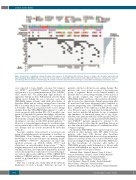Page 250 - 2021_03-Haematologica-web
P. 250
Letters to the Editor
Figure 2. Landscape of mutations, salvage therapies, and responses in 41 patients with refractory disease or relapse after front-line venetoclax and hypomethylating agent (HMA). AML: acute myeloid leukemia; sAML: secondary AML; tAML: treatment-related AML; ELN: European LeukemiaNet; IC: intensive chemotherapy; NIC: non-intensive chemotherapy; CR: complete remission; CRi: incomplete hematologic recovery; MLFS: morphologica leukemia-free state.
were expected to have durable outcomes but relapsed, e.g., NPM1mut and IDH1/2mut patients, had adverse-risk cytogenetics or co-occurring mutations in TP53, N/KRAS, FLT3, and/or KIT. The particularly high incidence of aggressive biology in these R/R patients was the likely driving factor behind the poor outcomes seen after VEN+HMA failure. Patients with AML after failure of front-line HMA and no salvage therapy have a median OS of 2 months which was comparable to our report of 1.3 months.9 However, for patients who receive salvage therapy, front-line VEN+HMA failure appears to confer a worse prognosis with median OS of 2.9 months com- pared to 9.5 months for patients after failure of front-line HMA.9 We believe that incorporating FLT3 inhibitors in the front-line setting as triplets with VEN+HMA may fur- ther improve outcomes in older FLT3-mutant patients.10,11 However, a sequential approach may be worth investiga- tion in patients who achieve excellent response to induc- tion therapy and are closely monitored by molecular methods.
Genomic analysis demonstrated a heterogeneous group of underlying genetic mechanisms of resistance to VEN+HMA. These findings add to the accumulating knowledge of venetoclax-resistance mechanisms includ- ing N/KRASmut, PTPN11mut, dependence on other anti- apoptotic proteins, e.g., BCL-XL, MCL1; TP53mut and alterations in mitochondrial homeostasis.12-15 These insights may provide new directions for biological under- standing and drug development in populations that fail venetoclax and provide a rationale to test novel therapeu- tics such as spliceosome inhibitors, MCL1, MDM2, BET inhibitors, PRIMA1 analogs, and others in VEN-resistant models as potential ways to prevent or abrogate such resistance.16-18
This was a retrospective study with all the inherent limitations of such a design. Forty-two percent of
patients could not or did not receive salvage therapy. The patients who were treated received a heterogeneous group of regimens. Based on the limited number of patients who received salvage therapy, it was unclear if any specific regimen was superior after front-line VEN+HMA failure, and hence these patients should ide- ally be treated on clinical trials. Patients progressing after IC may have had better functional status compared to patients progressing after VEN+HMA, and this could have contributed to the difference in OS after progres- sion. However, age is one important determinant of ‘fit- ness’ and we matched all patients for age to minimize this imbalance in functional status due to age alone. Notably, some patients with FLT3-ITD responded well to salvage regimens with second-generation FLT3 inhibitors and N/KRASmut patients appeared to respond to IC. Additional work on dissecting the underlying biology in pre-clinical models and testing novel combinations in this setting is ongoing.19
In summary, VEN+HMA offers superior responses and survival in older patients with ND AML; however, patients who have R/R disease after front-line VEN+HMA display high-risk disease biology and particu- larly poor survival. In this era of venetoclax-based regi- mens increasingly being utilized as front-line AML thera- py, this knowledge of outcomes after failure of VEN+HMA provides useful information to discuss with patients and highlights the urgent need for novel thera- pies to abrogate venetoclax resistance.
Abhishek Maiti,1 Caitlin R. Rausch,2 Jorge E. Cortes,3 Naveen Pemmaraju,3 Naval G. Daver,3 Farhad Ravandi,3 Guillermo Garcia-Manero,3 Gautam Borthakur,3
Kiran Naqvi,3 Maro Ohanian,3 Nicholas J. Short,3
Yesid Alvarado,3 Tapan M. Kadia,3 Koichi Takahashi,3
Musa Yilmaz,3 Nitin Jain,3 Steven Kornblau,3
Guillermo Montalban-Bravo,1 Koji Sasaki,3 Michael Andreeff,3
896
haematologica | 2021; 106(3)


